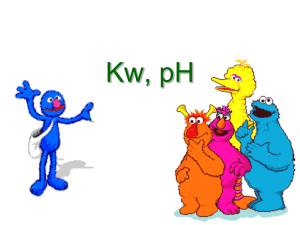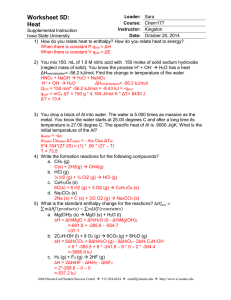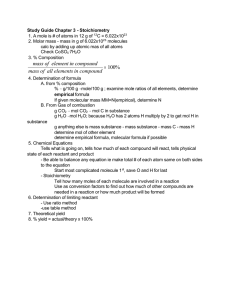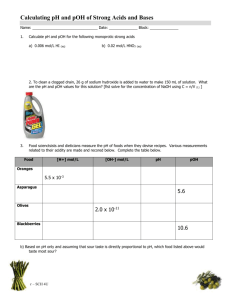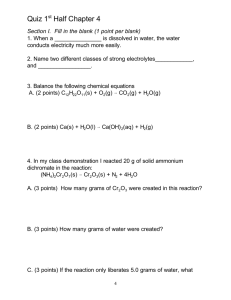Name:_____________ Chemistry 114 Fourth Hour Exam
advertisement
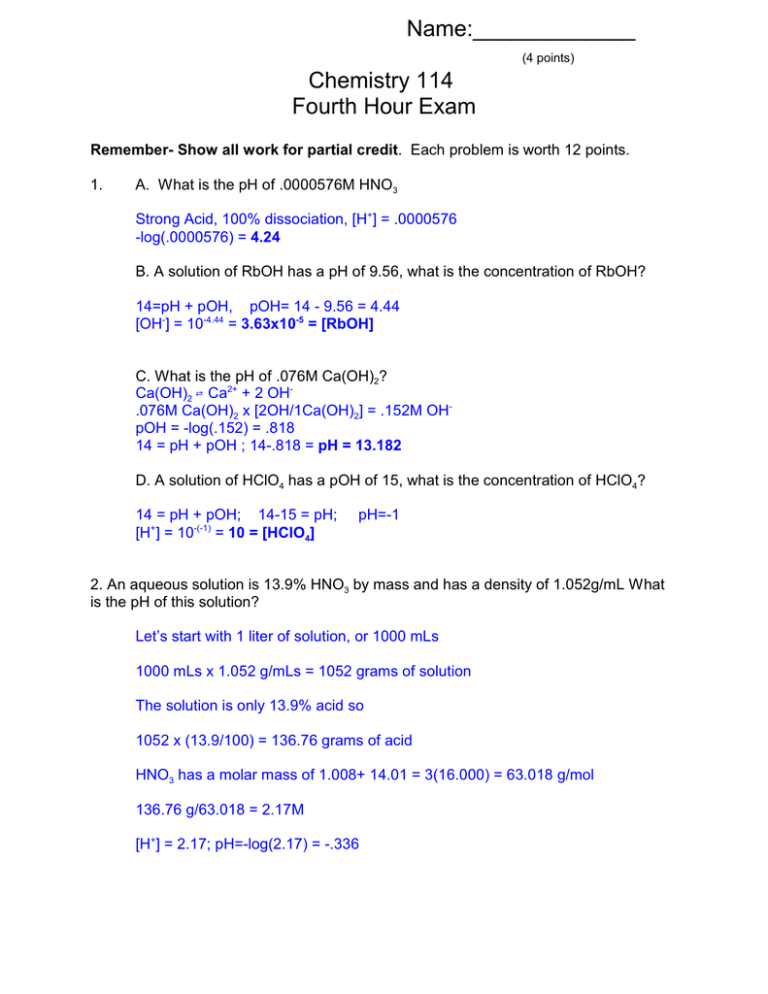
Name:_____________ (4 points) Chemistry 114 Fourth Hour Exam Remember- Show all work for partial credit. Each problem is worth 12 points. 1. A. What is the pH of .0000576M HNO3 Strong Acid, 100% dissociation, [H+] = .0000576 -log(.0000576) = 4.24 B. A solution of RbOH has a pH of 9.56, what is the concentration of RbOH? 14=pH + pOH, pOH= 14 - 9.56 = 4.44 [OH-] = 10-4.44 = 3.63x10-5 = [RbOH] C. What is the pH of .076M Ca(OH)2? Ca(OH)2 W Ca2+ + 2 OH.076M Ca(OH)2 x [2OH/1Ca(OH)2] = .152M OHpOH = -log(.152) = .818 14 = pH + pOH ; 14-.818 = pH = 13.182 D. A solution of HClO4 has a pOH of 15, what is the concentration of HClO4? 14 = pH + pOH; 14-15 = pH; [H+] = 10-(-1) = 10 = [HClO4] pH=-1 2. An aqueous solution is 13.9% HNO3 by mass and has a density of 1.052g/mL What is the pH of this solution? Let’s start with 1 liter of solution, or 1000 mLs 1000 mLs x 1.052 g/mLs = 1052 grams of solution The solution is only 13.9% acid so 1052 x (13.9/100) = 136.76 grams of acid HNO3 has a molar mass of 1.008+ 14.01 = 3(16.000) = 63.018 g/mol 136.76 g/63.018 = 2.17M [H+] = 2.17; pH=-log(2.17) = -.336 2 3. A. (9 points) Hydrazoic acid (HN3) has a Ka of 3.0x10-5. What is the pH of a .001M solution of Hydrazoic acid. Weak acid problem I C E HA W H+ + A.001 0 0 -X +X +X .001-X X X Ka = 3x10-5 = X2/(.001-X) Ka is small enough that we can approximate that .001 ~ .001-X Ka = 3x10-5 = X2/(.001) X = [H+] = [A-] = sqrt(.001 x 3x10-5) = 1.73x10-4 pH = -log(1.73x10-4 = 3.76 If you used the quadratic I gave you some bonus points and the answer was 3.80 about an 8% error 3B. (3 points) What is the KB of the Hydrazoic anion, N3-? This is the conjugate base of a weak acid so Kw = Ka @Kb Kw/Ka = Kb = 1x10-14/3x10-5 = 3.33x10-10 4. Classify the following compounds as strong acids (SA), Weak Acids (WA) Neutral (N), Weak bases (WB), or strong bases (SB) _WA____ HNO2 (Ka = 5.6x10-4) _WB____ CH3NH2 (Kb = 4.6x10-4) _WA____ CH3NH3ClO4 _WB____ KNO2 __B___ MgO Could be either strong or weak __A___ NO2 Could be either strong or weak 3 5. Define the following terms: Lewis Acid An electron pair acceptor Conjugate acid What remains after a weak base has accepted a proton pOH -log[OH-] Stoichiometric point In a titration it is the point where the moles of titrant exactly equals the moles of analyte. In the case of acids and bases, moles of acid = moles of base. amphoteric A substance that can act as either an acid or a base. spontaneous process A process that will occur without the addition of energy from an outside source. entropy driven reaction A chemical reaction that is spontaneous because ÄS is positive. Second law of thermodynamics The entropy of the universe is always increasing. 6. Circle the compound with the higher S in the following sets AND EXPLAIN WHY H2O (l) H2O(s) WHY: Liquids more random than solids H2O @ 200C H2O @ 45oC WHY: At higher temp, more motion so more randomness NaCl(s) NaCl(aq) WHY: Aqueous ions more random than a solid F2(g) Cl2(g) WHY: Greater mass so more energy levels at a given temperature. C2H2(l) C2H6(l) WHY: More atoms so more motion and more randomness WHY: The square compound has restricted motion so it is less random 4 7. The ÄHVap for water is 40.65 kJ/mol @ 1000C. What is the ÄSVap at this temperature ÄS = q/T At constant pressure ÄHÄ=q ÄS = ÄH/T T must be in K ÄS = 40.65 kJ/mol/ 373K = .109 kJ/mol@K Or 109 J/mol@K 8. A( 6 points) . Calculate ÄGrxn for the reaction C2H4(g) + H2O(g)6C2H5OH(g) given the following data: ÄGf0 (kJ/mol) C2H4(g) +68.4 ÄGrxn = sum of ÄGfo products - ÄGfo reactants C2H5OH(g) -167.9 C2H5OH(l) -174.8 = -167.9 -[68.4 + (-228.6)] = -167.9 -(-160.2) H2O(g) -228.6 H2O(l) -237.1 = -7.7 kJ/mol B (6 points). Given the ÄGrxn found in part A, determine the K for this reaction at 25o C (NOTE: If you did not calculate a ÄGrxn in part A, TAKE A GUESS so I can give you credit for this calculation) ÄG = -RTlnK -7.7 kJ/mol = -8.314 J/mol x 298K x lnK -7700 J/mol / (-8.314 x 298) = lnK 3.11 = lnK e3.11 =K K= 22.42


